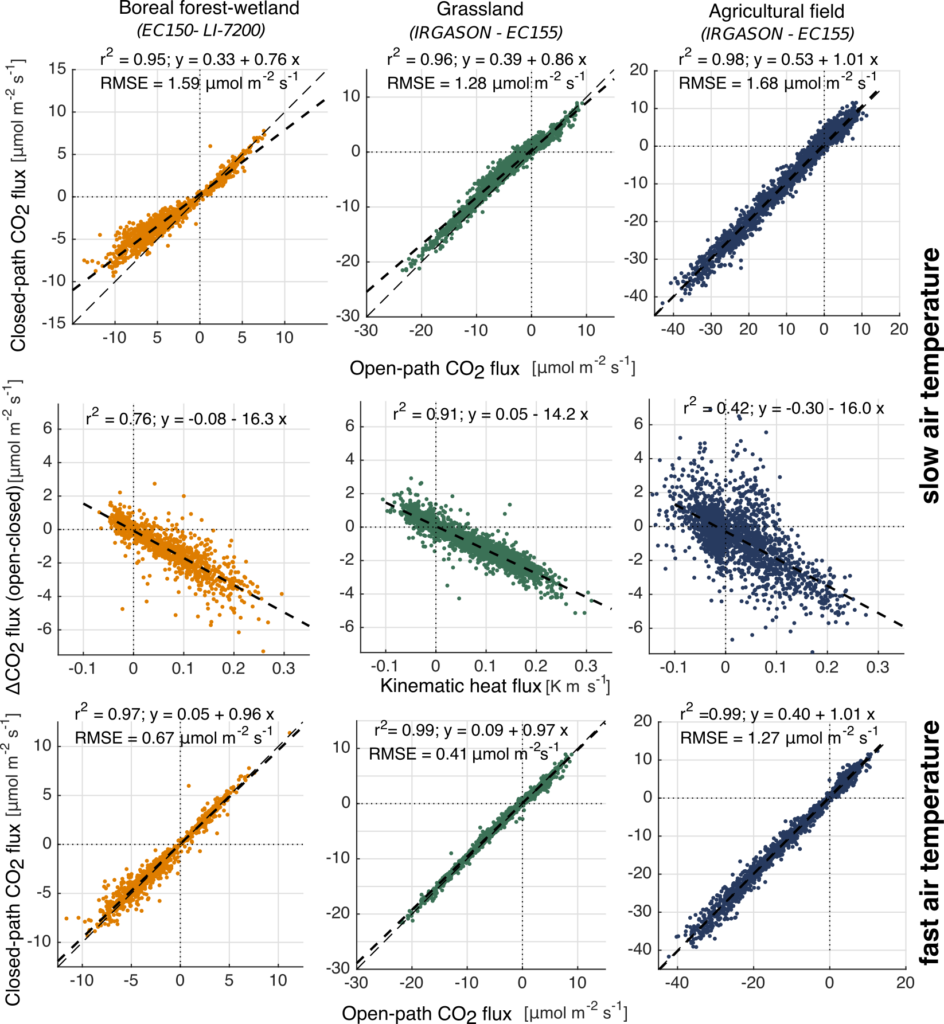Updated May 24, 2017 to include response from Campbell Scientific (see bottom of post).
Across FLUXNET, CO2 fluxes between ecosystems and the atmosphere are measured using various open- and closed-path gas analyzers. A few years ago, Campbell Scientific introduced new open-path CO2/H2O gas analyzers (IRGA; EC150 and IRGASON), thus, further diversifying the choices for eddy covariance instrumentation. However, until recently, the performance of these two sensors for CO2 flux measurements hadn’t been assessed. Last year, our study in Agricultural and Forest Meteorology identified a systematic bias in CO2 fluxes derived with these two sensors and has successfully tested a novel approach to improve the quality of the obtained CO2 fluxes.
During my PhD research, I used Campbell Scientific’s new open-path IRGAs to measure CO2 fluxes over wetlands and boreal forests in the Northwest Territories of Canada. We found that wintertime CO2 fluxes over these contrasting high-latitude ecosystems were drastically different, but also scaled closely with the magnitude of the sensible heat fluxes. These observations led to a broader effort to test and evaluate the performance of these two IRGAs for CO2 flux measurements across different ecosystem types.
Our study revealed that differences in CO2 fluxes from open- and closed-path IRGAs scaled with kinematic heat flux and that these relationships were largely independent of CO2 and energy flux regimes at the study sites. Absolute biases at a boreal forest-wetland, a grassland, and an irrigated agricultural field were very similar and ranged between +2 μmol m-2 s-1 and -4 μmol m-2 s-1. However, due to the large differences in “true” CO2 flux magnitudes, relative biases ranged from 24 % at the northern low CO2 flux site and 1 % at the agricultural site.

The EC150 and the IRGASON both measure CO2 absorption, which is then scaled with air temperature and barometric pressure before being converted to CO2 density. In the past, this scaling was based on slow-response thermistor air temperature measurements. We found that the bias in CO2 flux measurements is minimized if a fast-response air temperature (from sonic anemometer measurements) is used for this absorption-to-CO2 density conversion. In the newest version of the EC100 operating system (OS v.7.01), the latter option provides an “alternative” CO2 density output for flux computations. With this option, we can derive two CO2 fluxes, the “fast-temperature” and the “slow-temperature” CO2 flux. These two fluxes can inform us now how seriously the instrument bias affects CO2 flux measurements at individual flux tower sites. Potentially, the relationship between differences between these two CO2 fluxes and the kinematic heat flux could also be used to post-correct older CO2 flux data.
The results of our study have substantially improved the quality of CO2 flux measurements with the EC150 and the IRGASON, but important questions remain unanswered and need to be discussed by the FLUXNET community. How do we treat flux data derived with the EC150 and the IRGASON that has been collected over the past years and that is known for being affected by a systematic bias? Can we agree on, or do we even need, a post-processing solution for these legacy data? Discussing these questions within the FLUXNET community may then help us to improve comparability between flux tower sites with differing setups, a question that becomes increasingly important with a diversifying choice of gas analyzers.
References:
Link to EC150 gas analyzer: https://www.campbellsci.com/ec150
Link to Agricultural and Forest Meteorology paper: http://www.sciencedirect.com/science/article/pii/S0168192316303446
Link to another relevant performance paper: http://journals.ametsoc.org/doi/abs/10.1175/JTECH-D-15-0149.1
Author information:
Manuel Helbig
Department of Geography
Université de Montréal
email: manuel.helbig@umontreal.ca
Response from Campbell Scientific:
On May 24, 2017, Campbell Scientific provided a detailed response to address some of the questions raised herein. The response describes the new gas analyzer operating system that accounts for the spectroscopic effects using high frequency sonic temperature. The response also includes a methodology for examining (and correcting) the spectroscopic effects for a previously collected data. The details are included in this PDF document.

https://sensorsandtransmitters.com/